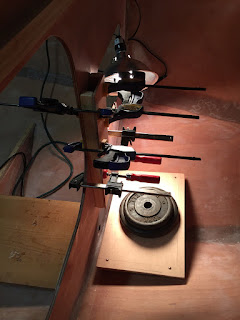Winter has definitely arrived in Virginia and it will be a challenge to work on the boat for the next few months. Not to say that I won't be able to do anything, but I will need to pick and choose. I think I will have many things that I can do. Winters in Virginia are fairly cold, but it all depends on the season. We do have days of warm weather in the upper 50's / low 60's and I will need to plan around those. My garage is not heated, but I did add insulation to the garage door last year and I have heat from the main house on 2.5 sides. As long as it doesn't get but so cold, I can keep it in the 50's with a portable heater and work lights.
Below is finishing my work on the floor boards. The problem I mentioned early about not having anything to screw the outer most floor board too, I decided to epoxy/screw them together. Since it was cold in the garage, I used work lights to heat them for a couple days.
 |
| Floor boards epoxy curing with work lights. |
 |
| Another view. They turned out pretty good, but I will need to sand them. |
A note to builders that purchase the timber package. You get all the correct wood and it is good that I got the milled package. Epoxying the outer 2 boards together worked fine. Having them milled, all the boards were square and same dimensions, which allowed them to look as one board when finished. I will post some more pictures of the finished floors when I get them completed and installed.
I have been looking/thinking about the lower breasthook for a while. Again I purchased the timber package and what was provided fit for the most part. Looking back, I think I would have put the lower breast hook in temporarily prior to doing any fillets and connecting the bow area. The piece of plywood that will go in the anchor well fits pretty good, but I will have to shave off a little to make it fit perfectly.
I think the word of caution is to think/read ahead and figure out the next move. The entire boat is a big puzzle and a slight movement of one part can cause other issues in other areas. With the kit, I have found that for the most part, things fit 99.9% of the time.
 |
| Lower Breasthook finally installed. |
I installed all the cleats, but have yet to put any epoxy on them. With all components, it is recommended that at least 2 coats of epoxy be applied on all components. Below are some pictures of after one coat of epoxy. I will put another coat on next week when it warms up a little.
As I mentioned earlier it is getting cold in Virginia. This weekend it is calling for a low of 6 and 9 degrees. I have been using a work light and plastic to keep it warm enough for the epoxy to cure. With temperatures calling for lows of 6 and 9 degrees, it will be difficult to keep anything warm. I have been using a single light to help with curing the epoxy on the cleats. With the plastic and work light, I have been able to keep the temperature in the low 50's with only a single work light(75watts). As a test, I will keep the lights on and monitor the temperature.
So how am I monitoring the temperature. I have a thermometer that has an outdoor sensor. I have placed the outdoor sensor inside the boat or anywhere in the garage I want to monitor. I can look at the high/low temp on the indoor unit to see where I am at. I have had this for many years, but I would recommend purchasing one. They are fairly cheap at any of the big hardware stores.

I read a lot of the other blogs as references and I would recommend that any new builders do so as well. There is a lot of great blogs out there and I reference them every time I get to a new step in the manual. I am doing this blog to help me remember how things came together, but if there are any question out there from readers, please let me know. I am definitely not an expert at building PocketShip. In fact this is the first boat I have ever built a boat. If anyone wants to see anything specific let me know and I will be happy to take pictures. I am also thinking about taking some video in the coming weeks of the build.




















